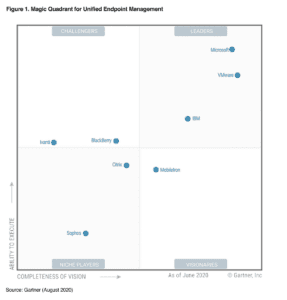IGEL Blog

Unified Endpoint Management Shake-Up: What it Says for EUC’s Future
Gartner’s 2020 Magic Quadrant for UEM Paints a New Story for Cloud Workspaces and DaaS
Gartner’s annual Magic Quadrant for Unified Endpoint Management (UEM) was just released and it reveals that the landscape for UEM is changing dramatically. See the following MQ comparison of 2019 to 2020:
2020:
2019:

Among the changes, year-over-year, are the “critical flaws” Gartner finds in traditional client management tools (CMTs) as they work to support remote clients during the global pandemic. For context, Gartner also made a number of changes to their definition of the UEM market, namely from their previous focus on mobile devices to a focus on the broader management of both mobile devices and PCs – especially their ability to “remotely deploy and provision devices, applications and updates and security patches.” This certainly is in response to the dramatic move to remote work.
Yes, millions of Windows-based desktops which were traditionally managed by client management tools (CMT) inside the safety of corporate walls, are now distributed, by the millions, to be used from home. These traditional management tools, including their security and policy control, were not built to handle such distributed environments. Nor are they equipped to manage devices remotely over the internet, or at such scale!
To solve this issue, millions of VPN licenses have been acquired in recent months in the hope they will deliver the secure data access remote workers need. But as work from home employees access data over VPNs, the traffic volume is becoming crippling and CMT solutions have failed to scale for other critical processes including device provisioning, deployment, patching and management.
Now, you add in the need for workers to collaborate, using tools including Zoom and MS Teams, and VPN solutions are not only limiting endpoint security, but breaking down user productivity.
It’s not a temporary problem either. As companies announce that their employees can work from home indefinitely – take Twitter, Facebook, Square and Zillow as examples – the VPN band aide won’t work long term any better than it’s working now.
Work from Home’s Security Risk
But the security need at the endpoint remains critical. A look into the UEM landscape shows that vendors in this space are still gravely missing the critical need to better secure work from home staff. IBM reports that as many as 50% of remote workers are using unmanaged BYOD or personal devices to access work data. Bitglass found that 72% of organizations lack BYOD malware protection.
And this exposure is giving rapid rise to ransomware attacks. CarbonBlack found that 148% of organizations saw an increase in ransomware attacks since COVID-19, and 51% of those ransomware attacks hit financial services organizations. Malicious emails are also on the rise, battering corporations through work from home users reacting to spam and phishing email campaigns. NHS in the UK, Travelex and Garmin are just some of the examples of successful attacks.
IGEL: The Ideal Solution to the UEM Conundrum
Enabling enhanced remote security and end user experience were among the inclusion criteria for this year’s UEM MQ. But, it’s also clear, if you look at named leaders Microsoft and VMware, that Gartner sees long-term value in enabling remote management via cloud- and virtualization-enabled UEM.
For example, Microsoft Endpoint Manager (MEM), when combined with Intune and Configuration Manager, and VMware’s Workspace ONE are both commended for their support of clients that are “geographically diversified.” Microsoft MEM is also reportedly “the most used UEM tool on the market” and offers “security capabilities that are difficult to replicate piecemeal.” And VMware Workspace ONE gained high marks in the Gartner report for offering “a seamless, device-agnostic user experience” while also delivering ease of use and flexibility across “traditional and modern PC and mobile management techniques through the same console.”
Now consider the UEM power when you combine one of these leading solutions with the secure, easy-to-manage IGEL OS. The power of the combination ensures that you have a secure, scalable and manageable option for the remote workforce – whether they are using a virtual desktop or Desktop-as-a-Service (DaaS) implementation.
Specifically, the combination eliminates the need for a VPN – eliminating bandwidth concerns. It efficiently powers the use of unified communications and collaboration tools, including Zoom and MS Teams, by running the application in a virtual channel and locally processing essential real-time communications components. And it helps to eliminate the risk of BYOD solutions being used to access corporate data by quickly transforming any x86 device into a secure workspace. As a result, Voila, your data is secure, your users are productive anywhere they want to work, and remote management is dramatically simplified.
Thus, as security concerns continue to grow around the endpoint and remote work, and more organizations experience increasing pain when managing physical devices remotely, IT doesn’t need to fret. Combining a UEM solution with IGEL OS-powered devices at the edge is the solution for reducing complexity and delivering location-agnostic device management for the secure device performance users want.
Feature image used under license from Adobe Stock.



